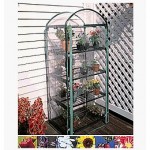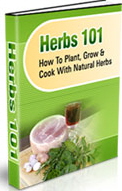Planting in containers
 Many home gardeners do not have access to outdoor garden space and have limited space for an indoor herb garden. If this is the case for you, then planting in containers is a great option. An herb garden in a container may be hung outside on a patio or balcony, or kept inside in a bright sunny window.
Many home gardeners do not have access to outdoor garden space and have limited space for an indoor herb garden. If this is the case for you, then planting in containers is a great option. An herb garden in a container may be hung outside on a patio or balcony, or kept inside in a bright sunny window.
There are many advantages to container gardens. They are flexible in smaller spaces, there are no issues with weeds, and they can be tended to day or night, regardless of weather. Additionally, you may move the container inside or out to take advantage of sunny days and natural rainstorms. A final benefit is year-round growth. You may move your herb container indoors before the first frost for fresh, tasty herbs all winter long.
You may also visit our Indoor Herb Garden page for even more information in indoor herb gardening.
Containers
The first choice you have is the type of container to use. Many container gardeners us window boxes, while other use terra cotta pots. Most of this choice is purely aesthetic, as either will serve well for a foundation of your indoor herb garden. Whatever container you choose to use, make sure to add small rocks or pieces of broken pots to the bottom to ensure proper draining. Herbs thrive in well-draining soil.
Soil
Having the right soil is a must for any home herb garden, and container gardens are no exceptions. An extra rich mix should be used for container gardening. You may purchase a rich potting mix from our local supplier, or you may make your own. If you make your own, be sure to include the following items into your mix:
- 4 parts soil
- 6 parts mature compost
- 1 part horticultural sand
Growing Herbs in Containers:
If you keep your container herb garden indoors, lighting is a primary concern. Make sure your herbs receive 6 to 8 hours of direct sunlight per day. Most south-west facing windows that are not obstructed by trees or other buildings will easily meet this requirement.
The size of your container herbs should be controlled to not allow for over growth. Regularly trimming and pruning the plants should keep the size under control. Once the plants mature, you may typically remove 30% of the branches and maintain a healthy, vibrant plant.
It is best to choose herbs that are known to do well in indoor planting. Our list of great indoor herbs includes the following:
Aloe
Basil
Chives
Ginger
Lemongrass
Marjoram
Mint
Oregano
Parsley
Rosemary
Sage
Thyme


